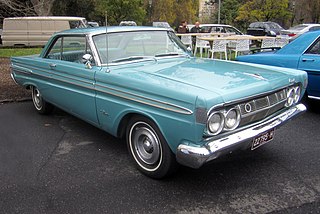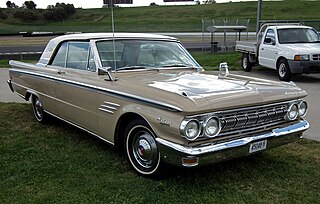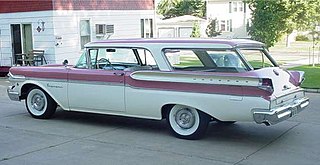
Mercury was a brand of mid-priced automobiles produced by American manufacturer Ford Motor Company between 1938 and 2011 with 1939 being the first model year. It stood as its own line within Ford until 1945, and thereafter formed half of Ford's Lincoln-Mercury Division. Created by Edsel Ford in 1938 to bridge the gap between the Ford and Lincoln model lines, its principal competition was General Motors' Buick and Oldsmobile divisions, and Chrysler Corporation's DeSoto and Chrysler brands.

The Mercury Comet is an automobile that was produced by Mercury from 1962–1969 and 1971–1977 — variously as either a compact or an intermediate car. Prior to being introduced as a Mercury in 1962, it was sold simply as the Comet from 1960-1961.

The Ford Galaxie is a car that was marketed by Ford in North America from the 1959 to 1974 model years. Deriving its nameplate from a marketing tie-in with the excitement surrounding the Space Race, the Galaxie was offered as a sedan within the full-size Ford range throughout its production run. In the full-size segment, the model line competed against the Chevrolet Impala and Dodge Polara.

The Ford Country Squire is a series of full-size station wagons that were assembled by American automaker Ford. Positioned as the top-level station wagon of the Ford division, the Country Squire was distinguished by woodgrain bodyside trim. From 1950 through the 1991 model years, eight generations of the Country Squire were produced. Following the discontinuation of Edsel Bermuda, Mercury marketed the Mercury Colony Park as a divisional counterpart of the Country Squire, sharing bodywork and trim while the Mercury was not available with a six cylinder engine and was more expensive due to the optional equipment on the Ford that was standard on the Mercury.

Buick Estate is a nameplate that was used by the Buick division of General Motors, denoting its luxury full-size station wagon from 1940 to 1964 and from 1970 to 1996. The Estate nameplate was derived from the term country estate in wealthy suburban areas and estate car, the British term for a station wagon.

The Plymouth Fury is a model of automobile that was produced by Plymouth from 1955 until 1989. It was introduced for the 1956 model year as a sub-series of the Plymouth Belvedere, becoming a separate series one level above the contemporary Belvedere for 1959. The Fury was a full-size car from 1959 until 1961, then a mid-size car from 1962 until 1964, again, a full-size car from 1965 through 1974, and again, a mid-size car from 1975 through 1978. From 1975 until 1977, the Fury was sold alongside the full-size Plymouth Gran Fury. In 1978, the B-body Fury was the largest Plymouth, and by 1979, there was no large Plymouth. This product gap was filled in 1980 with the R-body Gran Fury, followed by the M-body Fury in 1982. Production of the last V8, RWD Plymouth Fury ended at the Kenosha Main assembly plant in Kenosha, WI, on December 23, 1988. Unlike its sibling brand, Dodge, Plymouth would not live to see the resurgence of the large, V8/RWD sedan.

Meteor was a marque of automobiles offered by Ford Motor Company of Canada from 1949 to 1976. The make was retired for the 1962 and 1963 model years, when the name was used for the Mercury Meteor sold in the United States. It succeeded the Mercury 114, a Canadian-market Mercury based on the Ford, the "114" name being taken from the car's wheelbase.

The Mercury Montclair is a series of full-size sedans that were manufactured and marketed over five generations by the Mercury division of Ford. The nameplate was used by the division twice, from the 1955 to the 1960 model years and from the 1964 to the 1968 model years. The model was offered as two-door and four-door hardtops, four-door pillared sedan, and a two-door convertible.

The Mercury Park Lane is a full-sized automobile that was produced by the Mercury division of Ford Motor Company. While not officially introduced as the replacement of the Mercury Turnpike Cruiser, the Park Lane became the flagship of the Mercury model line upon its introduction. The second-generation Park Lane was positioned above the Mercury Montclair.

The Ford Custom is an automobile which was produced by Ford in the United States, Canada and Australia in certain years from 1949 to 1981.

The Mercury Colony Park is an American luxury full-size station wagon that was marketed by the Mercury division of Ford Motor Company between 1957 and 1991. Distinguished by its simulated wood-grain paneling, the Colony Park was marketed as either the premium-trim or the sole full-size station wagon offering of the division. Following the 1960 demise of Edsel, full-size Mercury vehicles shared bodywork with Ford; the Colony Park served as the counterpart of the Ford Country Squire through 1991.

The Mercury Marquis is a model line of automobiles marketed by Mercury from 1967 to 1986. Deriving its name from a title of French nobility, the Marquis was introduced as the divisional counterpart of the Ford LTD; four generations of the two model lines were paired through rebranding. Initially slotted as the flagship Mercury full-size range, the Marquis would serve as the basis for the later Mercury Grand Marquis.

The Chevrolet Brookwood is a series of full-size station wagons produced by Chevrolet from 1958 to 1961, and again from 1969 to 1972. It debuted in 1958 as Chevrolet's mid-range model in its station wagon lineup, positioned between the less expensive Yeoman and more luxurious Nomad station wagons. After the Yeoman was discontinued in 1959, the Brookwood was subsequently demoted to entry-level status, before going out of production altogether in 1961. It made a brief reappearance from 1969 and 1972, once again as the least-expensive wagon in Chevrolet's lineup.

The Chrysler Town & Country is an automobile which was manufactured by Chrysler from 1940 to 1942 and from 1945 to 1988 with production interrupted during World War II. Primarily produced as a luxury station wagon, the Town & Country was also available in "woodie" four-door sedan, two-door hardtop and convertible body styles from 1947 to 1950, 1968 to 1969 and from 1983 to 1986. The 1988 model year was the last for the station wagon until the 1990 model year when Chrysler reintroduced the Town & Country nameplate as the rebadged variant Chrysler Town & Country minivan.

The Mercury Meteor is an automobile that was produced by Mercury from the 1961 to 1963 model years. Adopting its nameplate from the namesake Ford of Canada brand, the Meteor was introduced as the base-trim full-size Mercury sedan, while the compact Mercury Comet shared a naming convention associated with the ongoing Space Race of the early 1960s. Slotted below the Mercury Monterey, the Meteor was the Mercury counterpart of the Ford Fairlane.

The Ford Country Sedan is a full-size station wagon that was built by Ford in the United States from 1952 until 1974. It was part of the U.S. Ford full-size car line available in each year.

The Mercury Monterey is a series of full-size cars that were manufactured and marketed by the Mercury division of Ford from 1950 to 1974. Deriving its name from Monterey Bay, the initial Mercury Monterey served as the top-of-the-line two-door sedan model for 1950 and 1951 to compete with the hardtop models of Oldsmobile and Buick. It came with a vinyl roof covering, upgraded upholstery, and other features. The hardtop was introduced for 1952. During its production, the Monterey would be offered in multiple body styles, ranging from coupes, convertibles, sedans, hardtops, and station wagons.
Full-size Ford is a term adopted for a long-running line of Ford vehicles with a shared model lineage in North America. Originating in 1908 with the Ford Model T, the line ended in 2019 with the Ford Taurus, as Ford withdrew from the full-sized sedan segment in North America. Across 111 years, 15 generations, and over 60 million examples of the model line were produced across over 50 model nameplates. By contrast, the longest-running single nameplate worldwide is the Chevrolet Suburban, in use since the 1935 model year.

The Mercury Voyager is a station wagon that was sold by the Mercury division of Ford for the 1957 and 1958 model years. For the 1957 model year, Mercury created a model range of station wagons distinct from sedans, following Ford. The Voyager served as the mid-range offering, slotted above the base-trim Mercury Commuter, with the woodgrained Colony Park serving as the top-range offering.

The Ford Ranch Wagon is a station wagon which was built by Ford in the United States from 1952 to 1974. The Ranch Wagon was a full-size model, except in 1963 and 1964, when it was part of the intermediate-size Fairlane series, and represented the lowest-priced selection in its respective line.

























